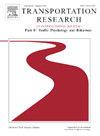Which electric vehicle charging station to upgrade? Biased judgments based on differences in station efficiency
IF 3.5
2区 工程技术
Q1 PSYCHOLOGY, APPLIED
Transportation Research Part F-Traffic Psychology and Behaviour
Pub Date : 2024-10-09
DOI:10.1016/j.trf.2024.10.001
引用次数: 0
Abstract
One way of controlling global warming is to substitute fuel driven cars with electric cars. Electric vehicles need to be charged. For maximal efficiency the charging times should be as short as possible. In the US charging stations are classified as Level 1 charging 5–10 miles/h, Level 2 25 miles/h and Fast DCFC stations 150–1000 miles/h. We asked participants to select one of two upgrades of charging stations that would save most charging time for a vehicle. The alternatives were upgrading L1 (5miles/h) to L2 (25 miles/h) or L2 (25miles/h) to Fast (250 miles/h). In all, 86% of the participants wanted to upgrade to a Fast station, which objectively saves less time than L1 to L2. The second study replicated the first study and 91% of the participants wanted to upgrade to the Fast (250) station. The third study offered alternatives with smaller objective efficiency differences than the earlier studies: upgrading L2 (30) to Fast (150) and Fast (150) to Fast (600) and 68% of the participants preferred the second incorrect alternative. Verbal justifications showed that many participants seemed to assume that differences in charging time are proportional to charging time saved. The results have practical implications and illustrate the difficulty to process reciprocal variables leading to incorrect decisions. Finally, we suggest two strategies for counteracting biased intuitive decision making when charging efficiencies are compared.
升级哪个电动汽车充电站?根据充电站效率的差异做出有偏差的判断
控制全球变暖的方法之一是用电动汽车取代燃油汽车。电动汽车需要充电。为了达到最高效率,充电时间应尽可能短。在美国,充电站分为一级充电站,充电速度为 5-10 英里/小时;二级充电站,充电速度为 25 英里/小时;快速直流FC 充电站,充电速度为 150-1000 英里/小时。我们要求参与者从两种充电站升级方案中选择一种,以节省最多的车辆充电时间。替代方案是将 L1 充电站(5 英里/小时)升级为 L2 充电站(25 英里/小时),或将 L2 充电站(25 英里/小时)升级为快速充电站(250 英里/小时)。总之,86% 的参与者希望升级到快速站,这客观上比 L1 升 L2 节省的时间更少。第二项研究重复了第一项研究,91% 的参与者希望升级到快速(250 英里/小时)车站。第三项研究提供了客观效率差异小于前几项研究的替代方案:将 L2(30)升级到快速(150)和将快速(150)升级到快速(600),68% 的参与者倾向于第二种不正确的替代方案。口头说明显示,许多参与者似乎认为充电时间的差异与节省的充电时间成正比。这些结果具有实际意义,说明了处理互变因素导致错误决策的难度。最后,我们提出了两种策略,以抵消在比较充电效率时直观决策的偏差。
本文章由计算机程序翻译,如有差异,请以英文原文为准。
求助全文
约1分钟内获得全文
求助全文
来源期刊
CiteScore
7.60
自引率
14.60%
发文量
239
审稿时长
71 days
期刊介绍:
Transportation Research Part F: Traffic Psychology and Behaviour focuses on the behavioural and psychological aspects of traffic and transport. The aim of the journal is to enhance theory development, improve the quality of empirical studies and to stimulate the application of research findings in practice. TRF provides a focus and a means of communication for the considerable amount of research activities that are now being carried out in this field. The journal provides a forum for transportation researchers, psychologists, ergonomists, engineers and policy-makers with an interest in traffic and transport psychology.

 求助内容:
求助内容: 应助结果提醒方式:
应助结果提醒方式:


